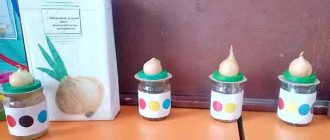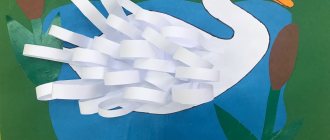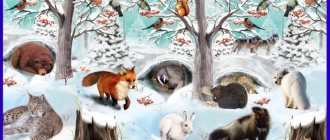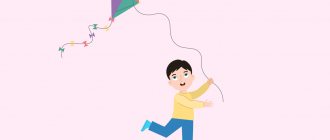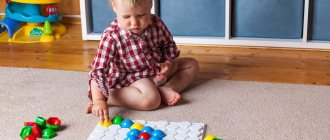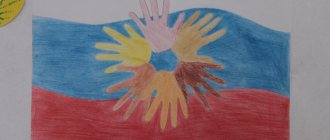Thinking
The accumulation of knowledge does not lead to the development of thinking; it is formed only in active practical and cognitive activity. The development of a preschooler’s thinking goes through 3 stages and represents a complex interrelation of various forms of thinking:
- Visual-effective thinking (3–5 years). The main feature is the inextricable connection of thought processes with practical actions that transform the cognizable object. To think, you need to act with objects. For example, a child spins a toy, presses all the buttons, tries to open it, thus he “experiments and learns with his hands.” In the process of repeated actions with objects (and over a couple of years, hundreds and thousands of different objects will pass through the child’s hands), the child identifies their hidden characteristics and internal connections. Practical actions with objects become a means of understanding reality and form thinking.
- Visual-figurative thinking (4–6 years old) - the child begins to think not with specific objects with the help of his hands, but with their images and ideas, well imagining such objects. The child learns to cognize and solve problems in his mind, relying on his figurative ideas about objects, whereas before this he could only through practical actions. Now, in order for the child to find out which figure fits which hole, he does not need to insert them alternately, he can do this in his mind and quite quickly.
It is worth considering that a child is not always able to come to the correct answer through visual-figurative thinking. His thinking may be strongly influenced by perception. If you show a child two absolutely identical and equal-in-volume balls of dough, and then in front of his eyes, turn one of the balls into a cake and ask where there is more dough, then the child will often declare that the amount of dough in the cake has increased. This thinking error is due to the fact that the child does not yet have the concept of volume and knowledge of other metric measurements. Visual models in which the properties and relationships of objects are reproduced are the most important condition for the formation of internal mental activity.
For the emergence of imaginative thinking, imitation of an adult is also important. By reproducing the actions of an adult, the child builds internal models of actions that he plays out in role-playing games.
3. Logical thinking - begins to take shape towards the end of preschool age (about 7 years) and develops over many years, allowing the child to master the principles of logic. Such thinking is characterized by the fact that as a result the child operates with rather abstract categories and establishes various relationships that are not presented in visual form. However, at first, it is easier for the child to establish cause-and-effect relationships if a specific object is right in front of him and the changes occurring with it can be directly observed. Gradually he moves to thinking that is more abstracted from the current situation.
Development of cognitive and research activities
From five to seven years of age, the cognitive activity of a preschooler begins to include research and experimentation.
You can take standard games (hide and seek) or play a game - find the hidden thing in the room, focusing on the “cold - hot” clues.
You should play the following educational game: several children take turns trying to explain the meaning of a word without naming it, the child must guess.
At preschool age, children learn to draw conclusions and conclusions, conduct experiments, through trial and error. It is very good at this time to develop creative abilities, form moral and moral values by showing high-quality cartoons and reading good books.
It is also important to pay attention to the child’s speech development. Practice on your own if you see any benefit in it, but when your child does not pronounce a certain letter for a long time or makes severe articulation errors, contact a speech therapist.
Children's experimentation
Sometimes another type of child’s thinking is identified - child experimentation. It represents the unity of visual-effective and visual-figurative thinking, and is aimed at knowing the properties and connections of objects.
Such thinking takes the form of experimenting with a phenomenon: the child causes or stops the phenomenon, changes it in one direction or another. In the process of such actions, the child receives new, sometimes unexpected information, which often leads to a change in ideas about the object. For example, a child puts a wooden boat in a stream and sees how it floats, then he takes his toy boat made of iron and sees how it goes to the bottom. The child is perplexed, because both toys are boats that should float, but one drowned. Then the child comes to the conclusion that not every boat is capable of sailing and begins to investigate this issue. In this experimentation, the moment of self-development is clearly presented: the use and transformation of an object/phenomenon reveals its new properties to the child, which, in turn, allow them to make guesses and bring them to life.
Experimentation encourages a child's curiosity and initiative, independence, flexibility of thinking, courage, and stimulates the search for new solutions and creativity. Independent experimentation gives the child the opportunity to try different ways of doing things, while removing the fear of making a mistake (since there is no right option). The ability to be surprised by new things, to make your own guesses, to ask yourself and others questions is more important in the development of thinking than the reproduction of ready-made patterns of action and the assimilation of knowledge given by adults. The role of an adult in this process comes down to creating special objects and situations that stimulate cognitive activity and experimentation.
Work experience “Development of cognitive activity of preschool children”
Natalia
Work experience “Development of cognitive activity of preschool children”
In our difficult, contradictory times, the question is especially acute: “How to raise a child today as a person of tomorrow? What knowledge should I give him on the road tomorrow?” Comprehension of this issue should occur through the awareness of a dramatically changed social order: yesterday a performer was needed, and today a creative person with an active life position , with his own logical thinking.
Federal Law “On Education in the Russian Federation”
defines a preschool educational organization as the first stage
the education system as a whole.
In the Concept of Russian Education, one of the main directions is the intellectual development of the younger generation, its cognitive activity . The education system today is focused on the education and development of an active creative personality capable of adapting to modern conditions and making non-standard decisions.
In accordance with the introduction of the Federal State Educational Standard for Preschool Education and the requirements for
The results of mastering the basic educational program, presented in the form of targets at the stage of completing the level of preschool education , put forward an important direction - curiosity.
The child asks questions to adults and peers, is interested in cause-and-effect relationships, tries to independently come up with explanations for natural phenomena and people’s actions, and is inclined to observe and experiment.
The desire to understand the world is inherent in the child at the biological level, but this desire must be developed . That is why, the Federal State Educational Standard for Additional Education directs the tasks and content of educational activities within the educational field “ Cognitive Development ”
to achieve the goals
of developing children's cognitive interests and intellectual potential.
Cognitive development is one of the most important areas of preschool
education. The task of teachers of preschool educational organizations is
create conditions, find the most successful ways of presenting information for
development of curiosity , cognitive activity , cognitive
children's abilities.
The problem of the development of cognitive activity
The problem of developing children's cognitive activity is not new.
for science.
For a long time, outstanding psychologists L. S. Vygotsky, A. N. Leontiev, N. N. Poddyakov, S. L. Rubinstein contributed to the study of this problem; teachers M. I. Lisina,
G. I. Shchukina, modern scientists V. V. Shchetinina, E. A. Menshikova, A. N. Nefedova, M. N. Polyakova and others.
The phenomenon of cognitive activity as one of the most important factors in learning constantly attracts the attention of researchers. Analysis of psychological and pedagogical literature shows that among researchers there is no single definition of the concept of “ cognitive activity ”
.
The concept of " cognitive activity "
Let's look at it from the perspective of different authors.
-An active state that manifests itself in the child’s attitude to the subject and process of this activity
T. I. Shamova.
development of cognitive activity based on the child’s overcoming
contradictions between the constantly growing cognitive needs and the possibilities of satisfying them that he currently has
V. S. Ilyin
-A person’s natural desire for knowledge , characteristics of activity, its intensity and integral personal education
T. I. Zubkova
E. I. Shcherbakova characterizes cognitive activity as “...the manifestation of independence, initiative, creativity in the process of activity, as well as the desire to learn, comprehend, understand, find, experience
the joy of success from independently finding a way to solve cognitive activity .”
According to V.V. Shchetinina, “ cognitive activity is a personality trait that manifests itself in relation to cognitive activity ,
presupposing a state of readiness, a desire for independent activity, aimed at the child’s assimilation of social experience , knowledge and methods of activity accumulated by mankind, finding
appearance in cognitive activity .”
Teachers such as S. A. Kozlova and T. A. Kulikova studied cognitive activity in preschool children They studied cognitive activity as an activity during which a child learns to understand the world around him , learns to analyze and compare objects in his immediate environment, and begins to establish relationships. The problem of developing this activity was the development of thinking , attention and speech.
The result of cognitive activity, regardless of the form of cognition in which it is carried out , is knowledge. This means that one of the problems in the development of cognitive activity is the formation of a system of elementary knowledge about objects and phenomena of the surrounding world, about the relationship between an adult and a child, about natural phenomena and their causes.
Taking into account the peculiarities of the development of preschool children , S. A. Kozlova notes that cognitive activity should be understood : “... activity that arises regarding cognition and in its process . It is expressed in an interested acceptance of information, a desire to clarify and deepen one’s knowledge, in an independent search for answers to questions of interest, in the manifestation of elements of creativity, in the ability to assimilate a method of cognition and apply it to other material.”
An interesting position is that of D. B. Godovikova, who believes that “ cognitive activity ”
- this is the desire to gain knowledge about the phenomena of the surrounding world, this is both
a cognitive need and the cognitive activity . Cognitive activity , in her opinion, has distinct external manifestations, based on which one can judge the nature of its organization.
What is the child interested in, what is the intensity of his desire to get acquainted with certain phenomena. M.I. Lisina confirms: “ Cognitive activity occupies a structural place in activity, close to the level of need. This is a state of readiness for cognitive activity .” From here it is clear that the concepts of curiosity and curiosity cognitive activity .
G. N. Shchukina considers curiosity as a stage of development
cognitive interest , which reveals quite strong
expressions of emotions of surprise, joy of knowledge , satisfaction
activities. Curiosity is characterized by a person's desire
penetrate beyond what is seen, becoming a stable character trait,
has significant value in personality development .
Children by nature are very curious and inquisitive . They show a steady interest in those objects that evoke involuntary attention in children.
“Curiosity is the tendency to acquire new knowledge,
inquisitiveness, a certain type of curiosity - “practical curiosity ”
- says E. A. Menshchikova.
According to T. A. Khabarova, “Encouraging children's curiosity , teacher
creates a need for research. The child has the opportunity
act with different objects and materials; a motive is formed,
associated with internal desires, to learn new unknown. The preschooler learns to independently explore various problems and discover new knowledge.”
Considering and analyzing these two concepts, we can conclude
that curiosity is the initial stage of the manifestation of cognitive
activity , most often not having a specific goal, but curiosity
we can characterize it as the desire for knowledge , the love of knowledge.
It is not difficult to recognize a child’s cognitive activity . More often
cognitive activity manifests itself in the process of perception and thinking
child. E. I. Shcherbakova believes that the most general indicators
cognitive activity of the child are:
— passion for the subject, story, activity;
- a pronounced desire to perform a variety of, especially complex
assignments, the desire to continue the lesson after its completion;
- demonstration of independence in the selection of means, methods of action,
achieving results, exercising control;
— communication with adults, questions aimed at cognitive interests ;
- emotional attitude to the subject (story, activity, etc.)
constant desire for it.
Children's cognitive activity has characteristic features:
- cognitive activity manifests itself from birth and intensively
develops throughout preschool age , going beyond its limits, providing the child with the accumulation of different ways of knowing the world around him ;
- cognitive activity is manifested in different types of activities,
as a rule, not characterized by purposefulness of cognition in a particular
sphere, the child is interested in everything that surrounds him;
-cognitive activity of a preschool child is bright
manifests itself in questions, comparison, experimentation, formulation and
solving various children's problems aimed at deeper
knowledge of surrounding objects and phenomena;
- a preschool shows interest and all-encompassing
curiosity from “what is this?”
to
“I want to know everything!”
.
So, what is stated in this paragraph allows us to formulate a working
definition of cognitive activity that we will use in
further work . The closest definition to us is
cognitive activity , which is given by S. A. Kozlova. She notes that this is an activity that arises regarding cognition and in its process , which is expressed in the interested acceptance of information, the desire to clarify, deepen one’s knowledge, in the independent search for answers to questions of interest, in the manifestation of elements of creativity, in the ability to assimilate the method of cognition and apply it on a different material.
Thus, we can draw the following conclusion: cognitive activity , with proper pedagogical organization of pupils’ activities and systematic and targeted educational activities, can and should become a stable personality trait of a preschooler and has a strong influence on his development .
Conditions for the formation of cognitive activity
Today in modern society there is a sharp increase in the number of children among preschoolers with an insufficient level of development of cognitive processes . In conditions of intensive changes in the surrounding life, the active penetration of scientific and technological progress into all spheres, and the informatization of preschool education, new opportunities are opening up for the development of methods and organizational forms of teaching and raising children.
Having studied the theoretical material on this issue, I came to the conclusion that it is necessary to deepen knowledge and study experimentation methods in more depth, because currently, in connection with the revision of priority forms and methods of teaching in preschool education, it is precisely the methods that develop in children abilities for initial forms of generalization, inference, abstraction. And this method is experimentation.
This is the basis for the choice of my topic for self-preparation: “Children’s experimentation as a means of cognitive activity in preschoolers .” This work experience was developed taking into account the requirements of pedagogy, didactics , and psychology.
Theoretical basis
Currently, certain aspects of children's experimentation are reflected in the works of N. N. Poddyakova, A. N. Poddyakova, O. V. Dybina, I. E. Kulikovskaya, N. N. Sovgir, A. I. Savenkova, O. V. Afanasyeva, N. G. Chernilova.
A. V. Zaporozhets, D. B. Elkonin, M. I. Lisin, E. E. Kravtsova in their works noted the importance of a child’s own activity when he acts as a full-fledged personality, the creator of his own activity, setting its goals, looking for ways and ways to achieve them. In other words, when a child acts as a free person realizing his will, his interests, his needs.
The studies of L. M. Manevtsova note the influence of search and research activities on the formation of cognitive interest in a preschooler , which manifests itself in active involvement in any activity, in the manifestation of a large number of questions, in children’s independent formulation and solution of cognitive problems .
S. L. Rubinstein wrote: “Thinking usually begins with a problem or question, with surprise or bewilderment, with a contradiction. This problematic situation determines the involvement of the individual in the thought process; it is always aimed at solving some problem.”
The goal of experimental learning, according to N. G. Chernilova, who views experimental learning as developmental , is to create conditions under which children:
- independently and willingly acquire missing knowledge from various sources;
- learn to use acquired knowledge to solve cognitive and practical problems ;
- acquire communication skills by working in various groups ;
-develop research skills (ability to identify problems, collect information, observe, conduct experiments, analyze, build hypotheses, generalize);
- develop systems thinking.
Professor - Academician N. N. Poddyakov, having analyzed and summarized his rich experience of research work in the preschool education system , came to the conclusion that experimentation is the leading activity in childhood.
The main advantage of the experimentation method is that it gives children real ideas about the various aspects of the object being studied, about its relationships with other objects and with the environment. During the experiment, the child’s memory is enriched, are activated , since the need constantly arises to perform operations of analysis and synthesis, comparison and classification, generalization and extrapolation. The need to give an account of what was seen, to formulate discovered patterns and conclusions stimulates the development of speech .
The consequence is not only the child’s familiarization with new facts, but also the accumulation of a fund of mental techniques and operations that are considered as mental skills.
Preschoolers are characterized by visual-effective and visual-figurative thinking, so experimentation, like no other method, corresponds to these age-related characteristics. In preschool age, he is the leader, and for the first three years he is practically the only way to understand the world . Children's experimentation as a specially organized activity contributes to the formation of a holistic picture of the world of a preschool and the foundations of his cultural knowledge of the world around him .
Consequently, the more actively a child touches , smells, experiments, explores, feels, observes, listens, reasons, analyzes, compares, and, therefore, actively participates in the educational process, the faster his cognitive abilities develop .
Types of experimental activities
Based on the nature of cognitive activity, three types of children’s experimentation can be distinguished.
Illustrative experimentation.
Children know the result of some process or action on an object, and experience confirms familiar facts. For example, children know that Easter cakes are best made from wet sand. Experiments on the ability of sand to absorb water and keep its shape illustrate this fact.
Exploratory experimentation.
The result of these actions on objects is unknown; it is proposed to obtain it experimentally . Children know that plants drink water, but how the liquid moves along the stem and leaves is unknown to them. To clarify this question, an experiment is carried out with colored water and Chinese cabbage leaves: the leaves are left overnight in glasses, and in the morning they see that they have acquired the color of that liquid that was "drank"
at night. The guys come to the conclusion that water consumed by a root or cutting moves in plants from bottom to top.
Cognitive experimentation.
During the lesson, learning conditions are created in which students select research methods to find answers. This type of experimentation is a practical component of the teaching method for solving cognitive problems . Experience "Beads in ice captivity"
, children try to solve a problematic situation by trying different ways to melt the ice.
Forms of organization of experimental activities
Various routine moments in kindergarten can be devoted to experimentation: educational activities, time on walks, themed leisure activities, holidays, independent activities of children in cognitive activity . In addition, elements of practical research can be included in music lessons (“Why do bells sound different? - Because they are made of different materials: wood, ceramics, metal, plastic.”) and physical education (“Which ball is more bouncy: leather, rubber, foam or plastic? Check."). Experimentation can be carried out in joint activities with the family: during consultations, the teacher gives instructions and descriptions of conducting various experiments at home and on the street.
Since the main activities of preschool are exploration and play, experimental activities should combine their elements:
games and experimental games .
The play activity of children 4–5 years old takes on a plot-based character; participants assign simple roles and come up with a story. By acting out exciting scenes, children satisfy their need for communication, share experiences . Experimental classes in the middle group can be completely structured in a playful form: a fictional character asks the children for help or creates a problem situation, voices tasks, directs the course of reasoning, drawing conclusions, etc. d. ;
Experimental lesson in kindergarten
An experimentation lesson in the middle group lasts no more than 20 minutes. When developing lesson notes, the teacher must select various forms of activity, taking into account the age and individual characteristics of the students. To prevent overwork, tasks from educational areas are alternated: gaming ( didactic and story games ), motor (physical education, outdoor games, dance breaks, aesthetic (listening to musical fragments and artistic texts, looking at illustrations in books and mini-exhibitions), speech (conducting educational and didactic conversations , educational (conducting experiments and experiments , observing processes, studying samples and mock-ups).
Having studied the methodological literature on children's experimental activities, I decided to adapt the practical material to the conditions of my group and created my own plan - program.
The plan-program included several sections:
- “Substance” - children get acquainted with substances and states of aggregation (solid, liquid, gaseous)
-"Liquid. Properties of water"
-“Snow and ice. Their properties"
-"Solid. Materials" (granite, clay, concrete, coal, chalk, etc.)
- “Structure of seeds”
-"Air. Its properties"
For the convenience of finding the necessary experiences and experiments , I systematized the description of the experiments included in the long-term planning in a card index .
Of no small importance in the development of children's activity is a well-equipped, rich subject-spatial environment, which stimulates the child's independent research activity and creates optimal conditions for intensifying the course of self-development . In connection with this, I have added an experimentation center, where conditions have been created for joint and independent experimentation and the development of children’s search activity . The center stores a variety of materials and equipment (laboratory glassware, magnifying glasses, samples of clay, sand, different types of stones, etc.). In the center I have created conditions for conducting experiments with water , soil, plants, etc. Children show great interest in research work , so I try to pay more attention to experiments and observations . Developed didactic games , manuals, games - exercises for research activities.
A competent combination of materials and equipment in the experimentation corner contributes to children’s mastery of means of cognitive activity , methods of action, examination of objects, and expansion of cognitive experience .
In order to systematize developmental work with children in the direction, I developed a long-term plan for working with children and parents on experimental activities for the middle group.
In my work I use only elementary experiences and experiments . Their elementary nature is:
- in the nature of the problems being solved: they are unknown only to children.
— in the process of these experiments , scientific discoveries do not occur, but elementary concepts and conclusions are formed.
- they are practically safe .
When conducting experiments I adhere to the following structure:
-formulation of the problem;
-search for ways to solve the problem;
-testing hypotheses and assumptions;
-discussion of the results obtained;
-formulation of conclusions;
This algorithm of work allows you to intensify mental activity and encourages children to conduct independent research.
To positively motivate children’s activities, I use various incentives:
-external stimuli (novelty, unusualness of the object)
;
- mystery, surprise;
- motive for help;
-cognitive moment (why this is so)
;
-situation of choice.
I carry out experimental work based on the prospects for the individual development of the child . All work takes place as a partnership between an adult and children, where the latter have the opportunity to demonstrate their own research activity . I build my research methodology on a game basis. This promotes the child’s development of activity , independence, the ability to make a decision, try to do something without fear that it will turn out wrong, evokes a desire to achieve, promotes emotional comfort, and the development of social and cognitive activities .
CONCLUSION
As a result of organizing children's experimentation, I came to the conclusion that children develop cognitive interest in various types of activities.
Through experimentation, children gain new knowledge, develop creativity and communication skills, and successfully adapt to the world around them. Children take part in learning new and interesting things with great pleasure. They try to independently solve accessible cognitive problems . Cognitive and research activities permeate all areas of children's life, including play activities. Play in research often develops into real creativity. Formalized consultation for parents: “Experimenting at home with children”
, made it possible to involve them in the process
of developing children’s cognitive interest , and to conduct experiments with children at home. Involving parents in working on the project, the majority realized that the experiment has an impact on the all-round development of the child .
I believe that the only way to teach a child to live in a rapidly changing world is to create conditions for him to fully develop his own abilities, not to point out the beaten path, but to help him find his own difficult path. Learn to set goals and go towards them. This is exactly what the research activities of preschoolers .
Phenomena of children's thinking by J. Piaget
At first, a child’s thinking is extremely imperfect and its main feature is egocentrism - when the child evaluates any situation only from his own position (point of view). What the child perceives seems to him to be the absolute and only possible option. The reason for this is insufficient separation between the Self and external reality.
An excellent example of egocentrism is the well-known test about brothers, where an adult asks a child:
- You have brothers? - Arthur. - Does he have a brother? - No. – How many brothers do you have in your family? - Two. - How many brothers do you have? - One. - Does he have brothers? - No, absolutely not.
The child does not realize that he may not be the “central” object, and therefore does not realize that his brother has brothers.
Jean Piaget identified other phenomena of children's thinking, which are based on egocentrism:
Animism is the attribution of animation to inanimate objects. Piaget reports the following conversation with a boy:
– Is the sun alive? - Alive. - Why? - It gives light. – Is the candle alive? – Alive, because it gives light. She is alive when she gives light, but not alive when she does not give it.
Artificialism is the understanding of natural phenomena by analogy with human activity or as created by man.
– What does the sun do when there are clouds and rain? – It is leaving due to bad weather. - Why? - Because it doesn't want to get caught in the rain.
Realism is the tendency to consider objects as they appear in their immediate perception. When the moon follows a child while walking, that means it is so. Or a three-year-old child may watch with interest as dad dresses up as Barmaley, but gets scared and cries when the costume and makeup are ready and he sees the terrifying image. Here another feature of children's thinking of this period is manifested: irreversibility, the inability to mentally return to the starting point. In this example, it is impossible to mentally remove the suit and mask from Barmaley and return to the original image of the pope.
Centering is focusing on only one, most noticeable aspect or feature of an object, while ignoring others, i.e. narrowly focused thinking. J. Piaget demonstrated the phenomenon of centering in his experiments on the understanding of conservation. In these experiments, J. Piaget shows that children at the pre-operational stage of thinking development (from 2 to 7 years) do not understand that the important characteristics of objects remain unchanged, despite changes in their appearance. To the problem below, the child will answer: there are more coins in the top row, the top stick is longer, there is more water in one of the glasses, etc. This happens because he is not yet able to correlate several parameters at once - the length of a row of coins with their number, the thickness of sticks with their length, the height and width of glasses with volume.
Conservation tasks developed by J. Piaget Source: [Burke, 2006] With the development of thinking, by the age of 7 the child overcomes egocentrism and most other thinking phenomena, moving to the level of logical thinking.
In general, children's thinking is still far from that of an adult, and it can be difficult for a child to figure out what is reality and what is pretense. For example, can witches really cast a spell on you or that a person can grow wings and fly like in a picture in a book.
